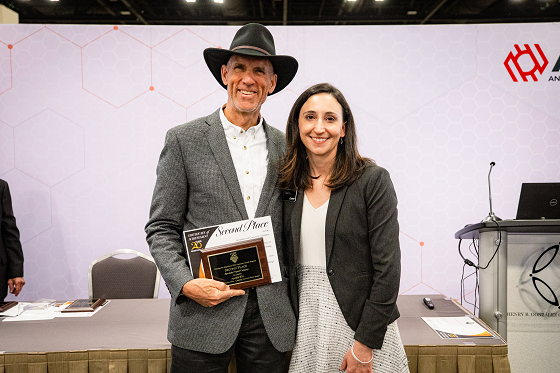Much has been written and discussed regarding workforce development challenges in the years ahead for the protective coatings industry. Could part of the solution come from technology?
Bob Dahlstrom, founder and CEO of aerial robotics company Apellix, believes companies like his may have the answers. “By 2026, there is actually projected to be over 100,000 painters needed to meet the current demand,” Dahlstrom said on a recent podcast from the CoatingsPro Interview Series.
A serial entrepreneur, Dahlstrom is passionate about designing and creating software-controlled robotic systems that keep people out of harm’s way and save lives. He is a frequent presenter on the use of robotic systems for nondestructive testing (NDT), inspection, and evaluation (NDE) and has presented at numerous conferences. He is author of a chapter on Robotic NDE Inspection in the Handbook of NDE 4.0, and he is also active with various standards bodies for robotic inspections.
“Robots are needed,” Dahlstrom said succinctly. “They’re something that can be utilized as a tool. Like any other tool, they’re only the right tool in the right circumstance. You don’t pull out a hammer when you need a screwdriver. But if you use these tools properly, you can replace what’s commonly referred to as the dull, dirty, and dangerous work, and spend your time as a corrosion specialist on higher-value things. You can delegate a lot of the grunt work, if you want to call it that, to some of these robotic systems. They’re very predictable, and they can do the same thing time after time.”
Winning Project
 In CoatingsPro’s 2022 Contractor Awards Program, Apellix FX+ (Field Services + Lab)
recently won second place in the Specialty Project category for the “City of Wooster, Ohio — Cleaning Elevated Water Tower” project. To complete this assignment, Apellix used a five-person crew to pressure wash and clean three structures using a tethered Opus X8 SW aerial robotic. The assets were 115 feet (35.1 m) tall, and according to the submission, “This was a man versus machine job completed in less than a day: 2.5 hours for the drone to clean half the tower, and 5 hours for the crew with a lift to clean the other half.”
In CoatingsPro’s 2022 Contractor Awards Program, Apellix FX+ (Field Services + Lab)
recently won second place in the Specialty Project category for the “City of Wooster, Ohio — Cleaning Elevated Water Tower” project. To complete this assignment, Apellix used a five-person crew to pressure wash and clean three structures using a tethered Opus X8 SW aerial robotic. The assets were 115 feet (35.1 m) tall, and according to the submission, “This was a man versus machine job completed in less than a day: 2.5 hours for the drone to clean half the tower, and 5 hours for the crew with a lift to clean the other half.”
According to Dahlstrom, the Wooster project is a classic example of how these robots can help. “About every five years in the Northeast, they clean these water towers, because they have a problem with mold and mildew growing on them. Not only does it aesthetically look bad, but it also can impact the longevity of the coatings systems.”
“So about every five years, they take people out on lifts and go up and power wash with a sodium hypochlorite chemical to kill the mold, and then rinse it with water to get all that biomass off of the structure — so that it doesn’t reattach and regrow,” Dahlstrom explained.
Using people to perform that task, though, carries its own risks and expenses for contractors, considering the high elevation and use of lifts. Scheduling can also be a problem at some locations due to access issues, Dahlstrom noted. That’s where drones come into play. “For people, it’s mindless, dull, dirty, and dangerous work,” he said. “You’re up there, and you get this stuff on your clothes… it’s a strong bleach, it ruins your clothes, and you can inhale it. It’s just not an environment where you want to be.”
“We did it with the drone,” Dahlstrom said of the Wooster project. “We had half of the tower done conventionally and half of the tower done with the drone. The productivity increased — we did in about half the time… And it put the person on the ground, where they were safe and out of harm’s way. It made the process much easier and much faster.”
The Apellix crew had approximately 3,000 psi (20.7 MPa) on the ground at its pump, and at approximately 131 feet (39.9 m) of elevation — the height of the water tower — Dahlstrom estimates that the crew had power of close to 1,000 psi (6.9 MPa) at the tip of the gun.

Future Endeavors
“These robotic systems have the capability to change the industry and change how we work and make it to where we can tap into our intelligence and do the smart things — and let the robots do the dumb things,” Dahlstrom concluded.
Apellix is also working on a spray painting drone, but Dahlstrom noted that it is still under development due to its increased complexity. However, for surface preparation, he is confident that drones are ready to take flight. More importantly, he believes the success of drones in surface preparation could make coatings contractors more open-minded to using drones for more complex tasks down the line, such as spray painting or nondestructive testing.
“If you’re trying to make physical contact with a structure with a drone, or paint with the drone, and you’re off by a couple inches, it’s a huge deal,” Dahlstrom said. “It could be catastrophic. So when we first started out a few years ago, wrapping your head around that level of complexity was hard for a lot of people.
“But now that people see this heavy-lift drone doing something relatively simple, i.e. squirting a bunch of water and chemicals on something to clean… I think it makes it much easier for people to say, ‘Oh, okay, yeah, it can spray paint. Yeah, it can make contact and take measurements under computer control.’ So, as these robotic systems evolve and change over time, we’re also going to find new use cases that the industry is going to come up with and where we can create value.”
The complete podcast episode with Apellix’s Bob Dahlstrom, which was recorded in April 2022, can be heard online at www.coatingspromag.com/podcasts.